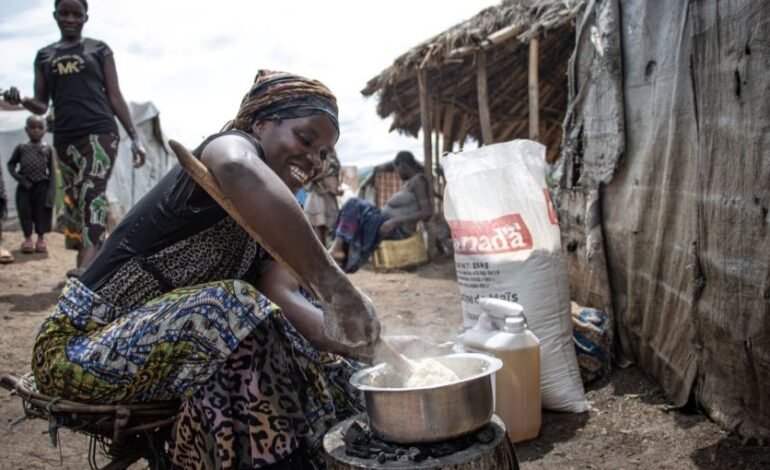As we mark World Refugee Day, it’s important to think about how conflict leads to hunger and how Christians are stepping up to help.
Kamara Chance, a young woman from eastern DR Congo, fled to the forest with her family when fighting broke out. “Finding food in the forest was tough,” she recalls. “We lived off the seeds we found.” Eventually, Kamara and her family made it to a displacement camp, but they arrived with nothing—no home, no job, and no food (check out the 6-minute YouTube video).
Meanwhile, thousands of miles away, Olena Slobodianiuk faced a similar situation when Russian troops occupied her village in Kherson, Ukraine. She and her family spent two long days traveling to Kyiv and spent a night in the fields. Although they were safe once they got to Kyiv, they struggled to find work and had very little money left after three months of occupation.
As Christians, we follow the Prince of Peace (Isaiah 9:6) and are called to seek peace (Psalm 34:14). But what does it mean to pursue peace in a world where conflict is driving hunger, poverty, and insecurity?
This World Refugee Day (June 20, or the Sunday before or after for some churches), we’re reminded that stories like Kamara’s and Olena’s are far too common. According to the World Bank, 69% of people facing severe food insecurity live in conflict zones. And in 2024, we’ve hit a record high for the number of refugees and displaced people.
So, how does conflict cause hunger? And what’s the Canadian Foodgrains Bank doing to help? Our mission is to see every person made in God’s image freed from hunger, and our food assistance programs play a key role in this effort.
For Kamara and Olena, Foodgrains Bank partners stepped up to provide crucial support. In DR Congo, ECC-MERU, with Mennonite Central Committee’s help, offered food transfers and helped Kamara’s family access land for farming and start new livelihoods. In Ukraine, ADRA Ukraine, supported by ADRA Canada, gave the Slobodianiuk family three months of cash assistance to help them get back on their feet in their new home.
The History of Conflict and Hunger
Between 1990 and 2010, global conflicts decreased significantly, but that trend has reversed. In the past decade, the number of active armed conflicts jumped from 33 to 55. Some conflicts, like those in Ukraine or Israel and Gaza, make headlines, but many others, such as those in Sudan or DR Congo, get less media attention.
Conflict has numerous consequences, and one of the most severe is hunger. As safety deteriorates, farmers can’t access their fields, and food prices go up. People often can’t afford food, and businesses and farms suffer as uncertainty grows. Armed groups might seize or destroy crops and livestock, further impacting people’s livelihoods.
Sometimes, warring parties use food as a weapon, blocking access to starve their opponents. Many people are forced to flee their homes, usually taking few belongings and facing limited job prospects when they arrive at a new location.
Conflict also has a ripple effect. For example, when Russia invaded Ukraine, a major food exporter, global food prices soared, hitting parts of East Africa and the Middle East hard. Similarly, conflict in eastern DR Congo affected food prices even in other areas of the country.
Hunger can also lead to conflict. Local disputes often arise over scarce resources, like in the Horn of Africa, where drought has led to clashes over water and pasture. Rising food prices were a key factor in the Arab Spring, leading to protests and civil wars that still impact countries like Syria and Yemen.
Conflict isn’t the only cause of hunger, but it’s the biggest driver of both hunger and displacement today.
Displacement at Record Levels
People displaced by conflict often arrive with nothing—no home, no income, and no food. As of 2023, there are 117.2 million forcibly displaced people worldwide, over three times the population of Canada. Of those, 70% are hosted in neighboring countries, many of which already face hunger issues.
Displacement often lasts a long time—an average of 10 years for those displaced within their own countries and 20 years for refugees. When I visited displacement camps in Somalia, many people had been there for over a decade due to both drought and conflict.
Life as a displaced person is tough. Jobs are often unstable with low pay and few legal protections, and finding affordable shelter can be a challenge. With limited ways to earn a living, many displaced people resort to negative coping strategies, leading to widespread hunger and struggling families.
Responding to Conflict, Displacement, and Hunger
Over the past year, Foodgrains Bank provided $28.7 million in food assistance to 250,000 people affected by conflict—three-quarters of our food aid response this year. Our major responses have been in conflict-affected countries like Syria, South Sudan, Somalia, and Lebanon.
For instance, in Syria, we’ve supported food aid for displaced people both within the country and as refugees in Lebanon. Syrian refugee Omar, living in Lebanon with his wife and kids, was making just $3.20 a day and could only afford basic food. With food vouchers from Popular Aid for Relief and Development, Omar’s family could buy nutritious foods like chicken and fruit, allowing them to eat three meals a day.
When providing support in high-displacement situations, we must be careful not to fuel further conflict. For example, if aid is only given to displaced people and not also to the host communities, it can create tension. That’s why our projects usually include both displaced people and local community members to prevent worsening the problem. In South Sudan, we’re supporting people fleeing conflict in Sudan while also helping the local communities that are hosting them.
Building Peace for Today and Tomorrow
While much of Foodgrains Bank’s work focuses on addressing the effects of conflict, we’ve also seen how our partners contribute to conflict resolution and peacebuilding. In DR Congo, ECC-MERU has set up Women’s Situation Rooms, where women trained as conflict mediators have helped resolve local disputes and even mediate between armed militias.
In South Sudan, Tearfund shared that, thanks to their training, women participated in peace negotiations between South Sudanese and Ugandan communities—marking a historic moment of women’s involvement in peace processes.
Looking Ahead
Conflict remains a major driver of hunger. The statistics can be overwhelming, but as Christians, observing World Refugee Day reminds us to pray—for peace, for the millions displaced, and for those facing hunger. Our hope is that, in time, we’ll see a reduction in conflict and a more peaceful world. Meanwhile, organizations like Foodgrains Bank will keep working to support those affected by conflict and strive towards a world without hunger.
Stefan Epp-Koop is the senior manager of humanitarian programs at Canadian Foodgrains Bank, a coalition of 15 church denominations and agencies working together to end hunger. Last fiscal year, the organization provided $79.8 million in assistance to 1,103,795 people across 36 countries. Their programs are supported by the Government of Canada (Global Affairs) and various local partners in the developing world. Photos by Esther N’sapu, courtesy of Canadian Foodgrains Bank.







